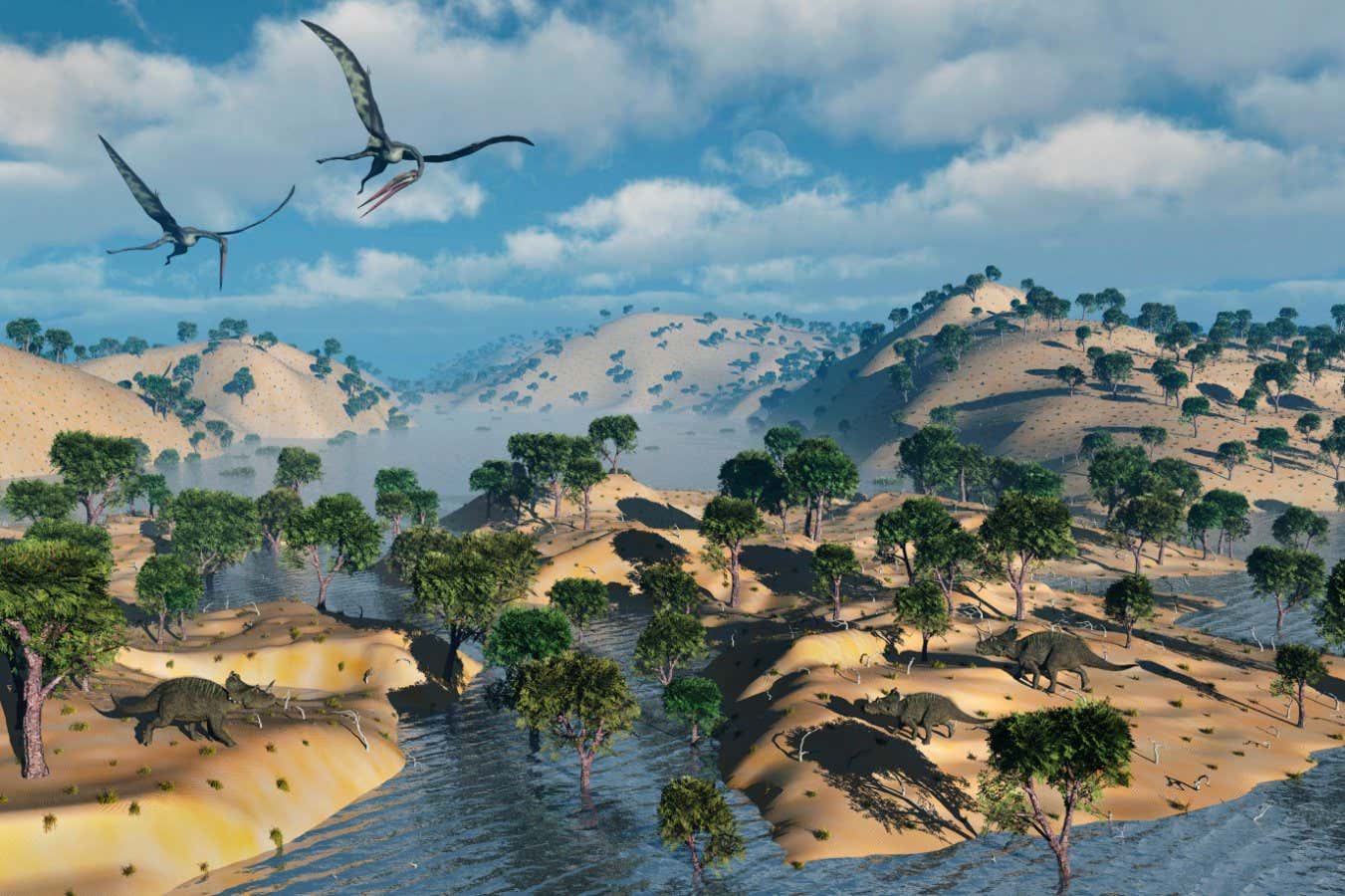
Illustration of pterosaurs over a Cretaceous landscape, in a time when Earth was warmer than today
MasPix / Alamy
During the past 500 million years – the time when animals and land plants evolved – the average surface temperature of the planet varied more widely and got even hotter than previously thought.
The mean global surface temperature over this time was 24°C (75°F) and sometimes reached 36°C (97°F), compared with around 14°C or 15°C (57-59°F) at present. The lowest it got was around 11°C (52°F) according to the most rigorous study so far.
Advertisement
“Our research suggests that temperatures during greenhouse intervals [when CO2 levels are high] can get warmer than is indicated by previous [studies],” says Emily Judd of the Smithsonian National Museum of Natural History in Washington DC.
In fact, during the hottest periods, average surface temperatures in the tropics reached 42°C (108°F), according to the study, meaning some land areas could have been too hot for plants and animals to survive. Even polar regions were warm during these times, with average temperatures exceeding 20°C (68°F).
“There were likely a few times over the last half billion years where certain regions were uninhabitable, or where the biodiversity in those regions was extremely low,” Judd says.
Her team also found a stronger link between carbon dioxide levels in the atmosphere and average global temperature than expected. Over such a long time span, the team had expected the relationship to be weaker because of other factors, such as the sun getting brighter.
“This was surprising,” Judd says. “It implies that atmospheric carbon dioxide concentrations play an even bigger role in regulating Earth’s climate than previously thought.”
Experts have long known that for most of the past 500 million years – a stretch known as the Phanerozoic Eon – Earth was hotter than present, with no large ice sheets. But exactly how warm was it?
The ratio of oxygen isotopes in some fossil shells can indicate past ocean temperature, but these are specific to just one part of the ocean. Climate models give a global overview, but because there is so much uncertainty about conditions in the distant past, models might diverge widely from reality.
So Judd and her colleagues combined the two. They ran hundreds of simulations with different starting conditions and assumptions and then picked the model runs that best matched the isotope data to calculate the average global surface temperature at specific times.
Because of their complexity, the models could only run simulations of a few thousand years at intervals of 5 million years, says team member Paul Valdes at the University of Bristol in the UK. “These are snapshot simulations,” he says. “It’s just impossible to run it time-continuous.”
This approach of combining measurements and models, known as data assimilation, is widely used in weather forecasting but had not been systematically applied to the climate over the past 500 million years before.
“This is beautiful work,” says Appy Sluijs at Utrecht University in the Netherlands. “It is the most complete record and best-organised attempt to get to a global mean temperature curve for the Phanerozoic.”
But this approach assumes the isotope temperature data is accurate and the models are right about the temperature of regions for which there is no data, Sluijs says. Such assumptions are not always correct, he says.
So these results are far from the final word on the Phanerozoic. But they do provide a foundation for further improvements, says Terry Isson at the University of Waikato in New Zealand.
“Refining estimates of surface temperatures during the Phanerozoic and also earlier in Earth’s history is critical for deepening our understanding of the co-evolution of life and its environment, and how the Earth’s climate system truly operates,” Isson says.
The fact that it was so much hotter at times in the past than in the present does not mean there is any less reason to worry about human-caused global warming, says Judd. What matters most is the rate of change.
Periods of rapid climate change in the past have led to mass extinctions because organisms couldn’t keep pace, she says. And the current rate of warming is even faster.
“Humans evolved to tolerate colder conditions and have established their populations close to water sources and often near sea level,” she says. “We are faced with challenges such as dwindling water resources, more frequent and intense storms, rising sea levels, and, ultimately, a reduction in habitable and arable land.”
Topics:
